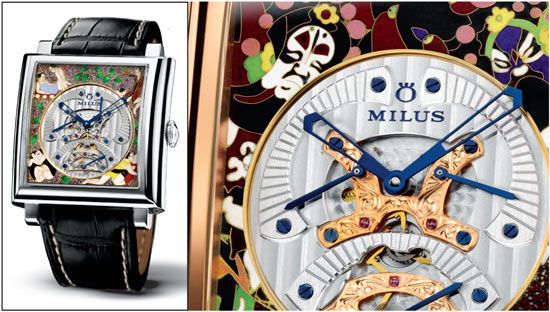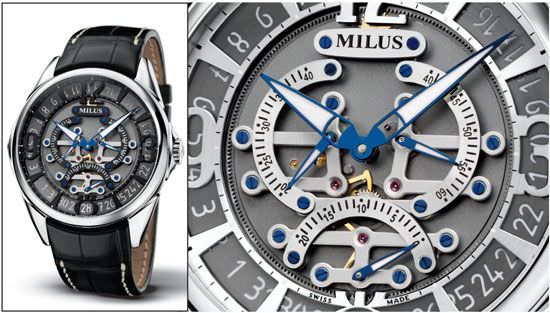The year 2009 marks a turning point for Milus—and for several reasons. This year, the brand that was founded in 1919 will celebrate its 90th anniversary. In 2009, Milus will also celebrate the fifth year of its relaunch under the direction of Jan Edöcs, who breathed new life into the brand. And lastly, 2009 will also mark a new turning point in its restructuration.

Milus HERIOS TriRetrograde Seconds Skeleton
Chow Tai Fook enters the picture
Following the dissolution of the Peace Mark group that, in 2002, had purchased Milus from Paul Junod, a descendant of the founder (who was a true pioneer, giving Milus an uncompromising design in the Bauhaus style, but who was way before his time, and who saw his ideas pilfered by the large fashion brands), Milus passed into the fold of another Chinese group, Chow Tai Fook.
Belonging to Dr. Cheng Yu Tung and his family, the Chow Tai Fook group is huge, with assets of more than US$32 billion, and 100,000 employees. Besides the financial investment branch, Chow Tai Fook is number one in jewellery and high jewellery sales in China, where it enjoys a 29 percent market share. The group manages 750 points of sale in more than 200 cities, not only in mainland China (including the networks acquired from Peace Mark and Tourneau), but also in Hong Kong, Macao, Taiwan, and Malaysia. Its sales in this sector are around US$2.5 billion. As a major retailer, the group also plays a central role in China and Hong Kong for many Swiss watch brands, including the most prestigious.
When Peace Mark failed, Chow Tai Fook saw the purchase of Milus as a rare opportunity to internationalize its strategy and to complete its portfolio of products by directly owning a brand in the haut de gamme sector. Milus was already well established in China, had a Swiss essence, and a palette of products that could complete or add to the group’s offer. (The group has publicly affirmed this strategy and interest in order to refute certain apparently unfounded rumours that it had only purely opportunistic motives.)

Milus TIRION TriRetrograde Seconds Skeleton
“Highly Personal” luxury
In any case, the acquisition of Milus is heatedly defended by Jan Edöcs who continues as head of the brand. Since he took over its management in 2002, Milus has undergone a profound transformation that has changed the entry-level “hard and fast” design brand into an original player in the luxury realm—a luxury under the sign of “Highly Personal”.
From a stylistic point of view, Milus’ offer is quite original and combines a mechanical refinement—the successful Tri-rétrograde line comes to mind—with a certain design boldness—as seen in the Monocera line among others—and a definite artistic refinement in the execution and decoration of the pieces. This strategy seems to have worked well for the brand. Since its actual relaunch in 2004 (the expected launch in 2003 was postponed, as you may remember, due to the SARS scare that greatly disrupted the participation of Asians at Baselworld), Milus has enjoyed a continuous rate of sales growth of around 200 percent per year, according to Edöcs.
Sales are also fairly equally divided between men’s (40 percent) and women’s timepieces (60 percent). The markets are also well balanced with Hong Kong and China accounting for 20 percent, Singapore, Malaysia, and Taiwan for 10 to 15 percent, the Middle East for 20 percent, and the USA for 20 percent (where Milus has a subsidiary). Russia and Eastern Europe account for about 15 percent, with the remaining sales divided between Europe and various other markets.
Honours to the Tri-retrograde
The current economic situation is certainly not helping anyone but Jan Edöcs, caught up in the turmoil of the dismantling of Peace Mark, has been forced by circumstances to anticipate and to closely analyze the brand’s “sell-out”. Already a few months ago, he was able to determine that buyers were primarily interested in the most “classic” pieces in his collection and that the high jewellery pieces and the most extravagant watches were less popular.
Milus decided therefore to concentrate on the essential during 2009, focusing mainly on the Tri-retrograde in steel or gold (average price: 8,900 CHF) as well as offering some limited series of fine watches mixing skeletonising and enamel. The brand will also launch a new line called Tirion that is round and also Tri-retrograde.
Playing on the contrasts between materials, colours, and levels, the open-work dials of the Tirion are set in very clean round cases made of nine component parts. By their continuous comings and goings between the three different segments where they are displayed (from 0 to 20 seconds, from 20 to 40 seconds, and from 40 to 60 seconds), the three seconds retrograde hands provide permanent animation for the watch with their continuing metronomic ballet. This mechanism, on an ETA base, was developed by watchmaker Jean-Marc Wiederrecht, who received the Grand Prix de l'Horlogerie for the best watch constructor in 2007.
In this spirit where the number “3” dominates, Milus is also launching a new campaign, centred around the product, which will be available in three themes: Body, Soul, Time. Come see it at BaselWorld 2009.
Source: Europa Star February-March 2009 Magazine Issue





